
Apple
Aperture 3 Metadata Issues
Update — January
31, 2011:
The Date Created field is still not appearing in images exported from
Aperture, but most of the other fields that were not appearing in Adobe
Bridge or Photoshop are now appearing properly. However, the Ampersand "&" character
issue described below has still not been fixed and will affect any images
saved as DNG files, or where the metadata is exported and saved as an XMP
sidecar (.xmp file).
I've
updated the Aperture
3 Exported Fields online spreadsheets with results of the
most recent tests.
Update —
November 18, 2010:
It's not clear whether this was an issue that existed in
previous versions, but I have discovered a new problem based on some troubles
that photographer David Gordon was having with exported XMP
sidecar
files generated
by Aperture
3.1 on a MacBook Pro running Mac OS X 10.6.5. His resulting Canon Raw files
(CR2 + xmp) were not recognised by Adobe DNG Convertor, PhotoMechanic,
Adobe
Bridge,
or Lightroom.. The problem turned out to be with the use of the Ampersand
"&" character. Based on the behavior in XMP file with and
without the "&" it appears that Aperture 3.1 is not doing a proper to/from
XML attribute parse on XMP data.
Executive Summary: Don't use the "&" character when entering data into
any metadata field in Aperture. Instead use "and" — and you will avoid
this issue.
Detailed explanation: If you are interested in why this causes a problem,
it's important to understand that there are a number of characters that
can't
exist
as values
in metadata
fields
without
being
specially treated. This is because they are the same characters that make
up the underlying XMP code (similar to HTML) and having them as values
confuses the reading of the information. When David Gordon tried to read
or process his CR2 + XMP combo, the applications tried to read the metadata
in the XMP sidecar and when they encountered the "&" symbol, either couldn't
make sense of the code and gave up; or couldn't read it at all because
it wasn't valid code.
In
addition to the "&" characters
such
as the
Greater Than ">" and
Less Than "<" symbols
are considered "illegal" in XML except to mark the beginning or ends of
tags or to mark the beginning of specific character entity codes. In HTML
the ampersand is assumed to begin an "entity" reference.
When Aperture "writes" the XMP sidecar the "&" should have been stored
as "&" instead. When reading a metadata field that includes a "&"
the application decodes and shows the value as "&" and everything works
just fine. Whether the Apple engineers assumed
that no-one would ever enter a "&" into a metadata field, or simply
forgot to write a routine into the Aperture software for those
times when
someone did use an "&" or other illegal characters and store them properly
is anyone guess. I would hope that they are now aware of the issue and
correct it in the next point upgrade.
If you are interested in the trouble-shooting methodology used in solving
this particular issue see the Apple
discussion forum.
Update — June 22,
2010 — The Good, the Bad, and the Ugly:
The Good:
Apple released OS 10.6.4 last week, with a note that this included
a fix for "compatibility issues with IPTC metadata" among other
things.
The good news is that the update to OS 10.6.4 has fixed the
problem which was causing all of the IPTC Core fields to not be visible when
exporting
TIFF and JPEG files. In addition, JPEG and TIFF images that had IPTC star
ratings applied in Photoshop or Photo Mechanic,now retained those star ratings
even after being ingested and modified in Aperture 3 (before being exported
back out as TIFF and JPEG files). Lastly, there seems to be much less of
a difference
between image's metadata whether they are viewed in Bridge or in Photoshop
(there were many more inconsistencies with versions of the OS prior to 10.6.4).
The Bad:
The
bad news is that the Date Created field is often not appearing in JPEG
or PSD files. This is the case whether these were files containing existing
metadata that were imported into Aperture or Raw image files
that were
only
annotated
in
Aperture 3. TIFF files, however do have a date in the Date Created field,
however in some instances it was appearing incorrectly in
some applications (the date should have read March 6, 2010, but was
showing as May 18, 2010 in Photo Mechanic). Additional bad news is that the
Star
ratings are not retained if you are exporting in the PSD format from
Aperture 3.
Files exported in the PSD format actually suffer a much greater
fate than loss of star ratings, as they also lose all of the IPTC Creator
Contact Info
fields. Creator Contact Address, City, State/Province, Postal Code, Country,
Phone, Email and Website fields are were no longer visible. In addtion
many of the IPTC codes (Scene, Subject and Genre) are not visible
when viewed in Photoshop CS3 or CS5 or Photo Mechanic (but Genre is visible
in Bridge). In the short term I would encourage Aperture 3 users to only
export TIFF or JPEG files.
The Ugly:
And
now the ugly news. IPTC Extension and PLUS metadata does
not survive a round-trip through Aperture 3. I had tested
this previously with Photoshop CS5 beta, but as that product had not
been publicly released, I decided
to hold off mentioning this in the February release. Here is the situation.
If I bring an image
that has IPTC Core, IPTC Extension, and PLUS metadata (all schemas are
stored in XMP)
only the IPTC Core metadata is preserved in the TIFF and JPEG images
that are exported from Aperture 3.0.3 (and yes this is after applying
Apples latest 10.6.4 update).
PSD files do not have IPTC Extension or PLUS metadata, and only a portion
of the IPTC Core metadata (as noted above). This is the case whether
viewed in Photoshop, or Bridge.
As Lightroom 3 now is supporting both the IPTC Core and IPTC
Extension metadata schemas — and the IPTC will be releasing a new IPTC-PLUS
metadata panel in
early July that will give users the ability to add or edit IPTC Core, IPTC
Extension and PLUS metadata in Bridge for Photoshop CS3 and CS4 — this
is a serious
issue that deserves further investigation.
XMP metadata is supposed to be "extensible" meaning that it is
flexible, and applications should preserve this information, even if they
don't necessarily know what it is about.
For comparison, I took an image contain all three of these metadata schemas,
and opened it in Photo Mechanic. I then modified several of the metadata
fields, and saved this updated information back into the file. When I went
back to view this in Photoshop CS5, and Bridge for CS5 (and with the new
un-released IPTC-PLUS metadata panel in Bridge for CS4), all three of these
metadata schemas were preserved.
I would expect Aperture 3 to work the same way, but instead the result is
ugly and Apple get's a "does not play well with others" score from
me.
The details of the original article as posted in February are
below. I've updated the Aperture
3 Exported Fields online spreadsheets with results of the most
recent tests.
Overview
(posted February 23, 2010):
I was initially enthused to hear that Apple's new version of
Aperture (released February 9, 2010) would be supporting XMP. I had been
noticing the incremental improvements within Apple's Preview program as more
and more XMP fields became visible. My understanding is that in order for
Apple programs to support XMP, this functionality had to be available at
the OS level first. With these advances known, I had hoped that the next
version of Aperture would be able to fully incorporate XMP support, and it
has. However after spending some time evaluating a number of exported files,
I have some real concerns regarding how Apple's new version, Aperture 3,
is writing metadata, especially when these files are viewed by other applications
in my workflow.
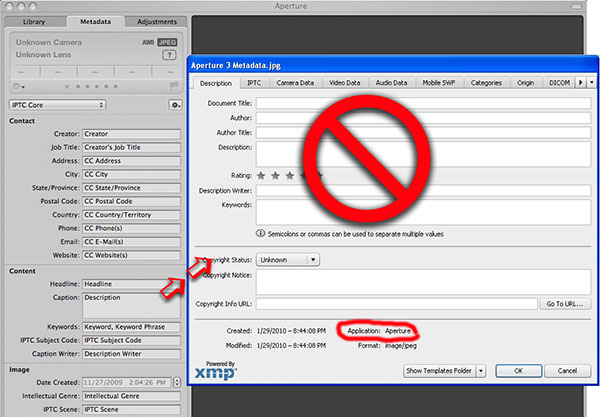
My comments solely focus on how Apple Aperture
handles embedded photo metadata, specifically on user-entered
descriptive and rights-related terms defined in the IPTC Core schema. Like
other software, Aperture 3 can read and write metadata stored in the older
IPTC's older binary Information
Interchange Model (IIM) and the
XMP based IPTC
Core. XMP Core support requires XMP support because it uses a sub-set
of the old IIM's terms in addition to new terms that can only be stored using
XMP. Many basic fields such as Captions
and Keywords, Creator (Author),
and Copyright Notice can exist in both the IPTC-IIM and IPTC Core, while other
newer fields such as the Rights Usage Terms only exist in IPTC Core
and these values are stored using XMP.
Should You Be Concerned?
Apple has made some significant changes to how Aperture handles
metadata with this latest release. However, the ways in which this has been
done should be of great concern to professional photographers that work with
other programs, or hand off their metadata-rich files to others who need
to be able to access the full range of that information.
You shouldn't be concerned if you use Aperture 3 on your own
Mac, don't typically use embedded metadata, and don't share your images with
others, or work with
other programs such as Adobe Photoshop.
Even if you do use metadata to describe your images, and only need to
find them on your local computer, you should be fine.
You should be concerned if you use Aperture to write
metadata to files you use with other programs, share with others or share
on the Internet. For example if you do additional work in Photoshop or Lightroom, and then
archive your images using
other programs, you need to understand what is happening, or risk having
some or all of your metadata disappear. Other programs may not see the information
you are adding to your images with Aperture, and if you are importing images
that have been worked on in other programs, some of that metadata may not
be recognized or stored within Aperture. You should really
be concerned if you are fully using the various metadata fields, such as
the Rights
Usage Terms,
or Location fields, or geo-tagging your images, as many of these
fields (and others), are not showing up in Photoshop, Adobe Bridge, Photo
Mechanic, or
Expression
Media,
after being exported from Aperture 3.
If you are a stock or assignment photographer, or a photojournalist,
then you should be concerned about what is happening with your metadata,
as files exported from Aperture might be viewed as potential orphan
works. This is because vital copyright management information may not be
visible within an image file when a client is trying to find your contact
information,
or read the caption in order to know what is going on in the image.
If you are concerned about the preservation of your embedded metadata, or
have concerns about interoperability with other applications, then using
Aperture 3 is certain to throw some obstacles in your path.
Where and
How does Aperture write Photo Metadata?
The Apple engineers
seem to enjoy pushing the envelope with new programs, but in order to fully
take advantage
of these advancements,
you typically
have to upgrade your hardware and/or update to the latest version of the
operating system. Aperture 3 is no exception. With this release it's
really essential to update your OS. If you don't, any TIFF, PSD, or JPEG
images will lose, on import, most of the fields that first appeared in IPTC
Core (which was released over five years ago). See the following Apple
support page for details. Apple's Aperture takes
a divergent approach to writing metadata. The vast majority of other applications, — such
as those listed in the list of Software
supporting IPTC photo metadata standards IIM and "IPTC Core" — write
metadata values to both the XMP and IPTC sections within an image, for any
field that exists in both schemas.
In Aperture 3, new IPTC Core terms that can only be recorded
using XMP are written to XMP — doing so doesn't create any problems.
However, older IPTC Core terms inherited from the legacy IPTC set of
terms are ONLY stored (written)
using the IIM format. The problem with this approach is that many applications
will only see one or the other (the XMP, or the IPTC-IIM) metadata written
to an image
file. Ideally any application reading embedded information should be
able to see the metadata values regardless of where they may have been
stored. Contrast this with the Adobe approach which is to have their
applications write metadata to both the IPTC-IIM and the XMP; unless
that information
only exists in a newer schema such as the IPTC Core.
It
is interesting to note that Aperture 3 does suppport a number of
legacy IIM fields that are not often used by other applications.
Most
of these values have never been supported by Adobe Photoshop, and
if you open a file from Aperture that contains these fields, like "Edit Status"
or "Category" it is unlikely they will be perserved after saving
the file in Photoshop.
As these are fields Which were "deprecated" (removed
from service), that is not unexpected. Aperture 3 (and possibly
Aperture
2 as well) also uses the IIM tag 1:90 to indicate UTF-8 encoding.
This prevents
characters
beyond
those in the standard ASCII set, to appear correctly, regardless
of the platform which is used for viewing the metadata.
In versions of Photoshop prior to version 7, letters like á, é, í, ó, ñ,
or even © might appear very differently if written using a Mac and then
viewed on a computer using the Windows operating system.
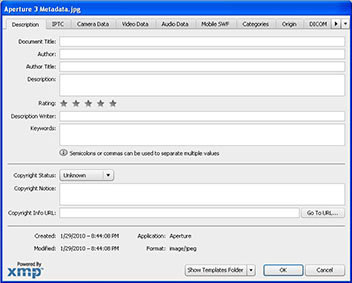
View original
image. Little to no metadata
is seen in
Adobe Photoshop CS4 when you view a JPEG file which has been exported
from Aperture 3.
What is not clear is what will happen with image files
that contain metadata written by other applications (especially extended
or custom
XMP
metadata), when they are imported into Aperture, and subsequently exported.
From some preliminary tests, any metadata outside of that entered in Aperture
3 appears to be stripped from the file. This violates the second and third
principles of the Metadata
Manifesto, namely that "Ownership metadata must never be
removed." as
well as "Metadata
must be written in formats that are understood by all."
I can't speak for others, but
any application or utility that undoes work that I've already done is
not desirable. In my book that makes work-slow,
not work-flow as I'll have to re-enter my metadata a second
time. Critics of Apple could certainly make the argument that while
Aperture 3 takes
one step forward (adding XMP support) the way that they have implemented
this
change takes two steps back in terms of interoperabilty with other applications.
So at this point
you are probably wondering what's not showing up in other programs.
Unfortunately, that is not so easy to explain as the results differ
by application (and even versions
of applications), as well as by file format. However, the results
do appear to be consistent for each specific combination.
Where
did my metadata go?
If we take a JPEG which was exported
from Aperture 3, and open it in Photoshop CS4, and then open the File
Info dialogue, we only see the following fields:
Date Created, IPTC Scene and the Creator Contact fields -- those
being: Contact Address, Contact City, Contact State, Contact
ZIP, Contact
Country, Contact
Email(s), Contact Phone(s), and Contact Web URL(s). There is no Caption,
no Keywords, no Rights Usage Terms, or even Instructions.
And while someone finding this image might be able to call me if it included
my phone number, they wouldn't know who to ask for when I picked up the phone!
It may be easier to visualize what is/is not in the specific
fields. To see that, click on the thumbnail below to see a full sized screen
capture.
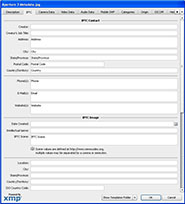
View original
image.
If I open that
same image using Photo Mechanic, (with preferences set to write metadata
for an Adobe workflow -- as indicated on
the Photo
Mechanic support page, then I see exactly the same fields
as above.

View original
image. (sample files provided by Richard Wagner, Wildnaturephotos.com)
Viewing the same file with Adobe Bridge for CS4,
yields a different, and more positive result.
Yet there are still a few fields missing, notably the Date Created, IPTC
Subject, Intellectual Genre, and Right Usage Terms
fields.
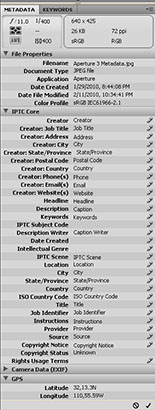
View original
image.
If you want the nitty gritty, you are encouraged to view the Aperture
3 Exported Fields spreadsheet that was used for gathering
this data. Note that there are several tabbed pages, each one detailing
the
results
of various file formats which were exported from Aperture 3. The initial
version only contained information on JPEG, TIFF, DNG and proprietary
Raw files, as viewed in Adobe CS3 and CS4,
Adobe Bridge for CS3 and CS4, Photo Mechanic and Expression
Media. On March 1st, I added two additional tabs, to include data from image
files
that were passed from Aperture to Photoshop CS4 using the Edit in External
Editor feature. On March 1st, I added two additional tabs, to include
data from image files
that were passed from Aperture to Photoshop CS4 using the Edit in External
Editor feature. Those six tabs correspond to the following:
-
JPEG = Jpeg file as exported from Aperture 3.
-
TIFF-exported
= TIFF file as exported from Aperture 3.
-
DNG = DNG file as exported from
Aperture 3.
-
Raw-NEF = NEF files viewed after using the Write IPTC
Metadata to Master in
Aperture 3.
-
Edit-in-ext-ed-TIFF = Opened using Edit in External
Editor feature,
then sized and saved as a TIFF in Photoshop CS4.
-
Edit-in-ext-ed-PSD
= Opened using Edit in External Editor feature, then sized
and saved as a Photoshop PSD file in Photoshop CS4.
Note that the TIFF files created via the Edit in External
Editor option results in a display that is quite different from the
TIFF files that are exported. It is important to note that the loss of
GPS data in the TIFF is an issue with how Photoshop CS4 is writing metadata
for
that
type
of data — this is known issue with CS4 and all prior versions of Photoshop.
What is Going On?
It's unclear if Aperture 3, by only writing values to the IPTC-IIM
location (rather than both IPTC-IIM and XMP) , is not conforming
to the XMP specification. Or, is it possible that both Adobe (who
wrote the specifications) as well as other developers
like Camera Bits (who make Photo Mechanic) or Expression Media (originally
developed by iView Multimedia, and now owned by Microsoft) all managed
to get it wrong?
Since Apple is a member of the Metadata
Working Group (MWG) one
would assume that this new version is abiding by the guidelines set out
in that MWG's white
paper Guidelines
for Handling Image Metadata. If that is so, then it is
possible that the other developers, such as Adobe are still in transition
(since most all of their applications were released before the MWG released
their guidelines). However, what's odd about this situation, is that Adobe
and most all of the
rest of
the imaging
applications
manage to exchange
metadata values with very few glitches or hitches — including newer
metadata schemas that are stored in XMP such as PLUS.
Writing out any IPTC metadata fields that exist in both the XMP and the
IIM is consistent
with the MWG guidelines and this is what Adobe has been doing all along.
One
could make an argument that Photoshop CS4 is the problem in this instance,
since it manages not to display most of the IPTC-IIM that Aperture 3 has
written to the exported JPEGs and TIFFs. However, there are also inconsistencies
with how other CS4 components (Camera Raw and Bridge) read the same files
from Aperture (as noted above CS4 was released prior
to the MWG Guidelines being published). In addition Photoshop CS3 and CS4
read all the IPTC and XMP from other software just fine (at least other
Adobe applications such
as Bridge
and Lightroom, as well as Photo Mechanic and Expression Media).
It may be possible that an MWG-compliant metadata reader might
see all of Aperture 3's IPTC metadata (both IPTC-IIM and XMP), but since
none of those exist at present; it is hard to know for sure.
Even
if
Apple
Aperture
3
is compliant
with the MWG guidelines, it's hard to imagine that the Apple engineers
didn't do any testing
to see what would
happen if you open files exported by Aperture into other programs. If
there
was a beta test, it's hard to believe that not a single one of the beta
testers noticed this issue.
I know from other reviews I've read that at least one National
Geographic photographer was included in the development of this release,
I would have
thought that metadata was something they would find important. Is this
Apple's attempt to keep their customers locked-in and within their
walled garden? Did
they test for interoperability and/or simply not care about other programs?
I hope that is not the case, but the results could lead you to that conclusion.
Other issues:
Aperture Ignores Non-IPTC Core XMP
Aperture appears to ignore any XMP outside the IPTC Core
properties, and use of the "Update IPTC in Master" feature
actually removes XMP metadata from master files which had been added
with other programs. As one
example, simply
updating a master file in the Aperture database would inadvertently remove
any PLUS metadata and IPTC extended properties, as well as Adobe Camera
Raw
settings.
If you
intend to use
both Aperture and Lightroom you will either want to work on separate copies
of the files (one file for each program), or decide only use one of them
for actually updating files on disk.
It is not possible to
set the Copyright Status pull down to "Copyrighted" within Aperture, as this
is not part of the IPTC or IPTC Core. For details on why this should not
be of major concern see the article "Is
Copyright Status Important?" on this
site.
Aperture 3 is Using Non-Standard Metadata Mappings
Aperture uses a number of non-recommended metadata mappings.
The IPTC Subject Code is mapped into an IPTC-IIM field called "Subject
Reference" and the "Intellectual Genre" field is mapped "Object
Attribute Reference" field. As those are not the recommendations in
the IPTC Core specification, and since Aperture 3 is not writing those into
XMP, this will create a real interoperability issue for any photographer
that chooses to use them.
Aperture 3 Writes Directly to Proprietary Raw Files
When you export your proprietary Raw files from Aperture 3, there are two
options and one of those involves writing metadata
directly to your original Raw file. Even if you discount the possibility
of file corruption,
writing
metadata
into the proprietary RAW file will create problems if you "round-trip" your
metadata to other programs that use XMP sidecars. If you do use Aperture
to write metadata — especially if you may be moving files to an
Adobe workflow in the future — be sure to use the option to "Create
IPTC4XMP Sidecar File" as this method seems to provide
better results with more applications. Better yet, work with DNG files
instead of the proprietary
Raw formats, as these do an even better job of preserving metadata between
applications. See the Aperture
3 Exported Fields spreadsheet for a comparison of the differences
between DNG and Nikon NEF files.
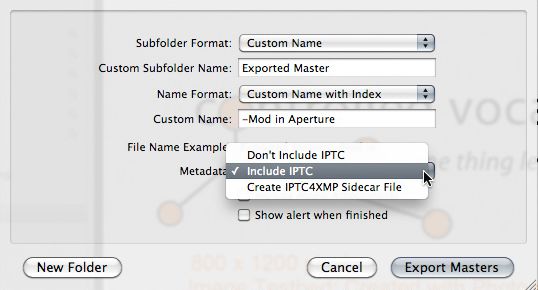
Facial Recognition Info can not be Embedded
Aperture 3 incorporates facial recognition
(the Faces feature similar to that in iPhoto) however; this information is
not embedded into the image.
So this information is not useable by other programs unless you manually
transfer this information (such as people's names) to the keywords or other
metadata field.
GPS appears to be embedded properly for both JPEG and TIFF files, though
DNG, and probably RAW files don't appear to have this info accessible once
you leave the program.
Send to Photoshop can remove Exif Info
If you use the feature
within Aperture to "Send
to Photoshop" you might also be interested to know that some Exif
information can be lost when using this feature according to Joseph Linaschke
at Aperture Expert
Aperture = Mac Only
Aperture is only available on the Mac platform. If you are a Windows-only
computer user, you are out of luck. And depending on which survey's you
find most accurate,
that either means that 65 percent of professional photographers won't be
able to use Aperture (according to a Professional Photographers of America
survey); or 52 percent of photographers (those that replied to The Digital
Photography School survey as that was how many respondents indicated that
they were not on the Mac platform).
Work arounds:
If
you don't use the Date Created, IPTC Subject, Intellectual Genre, or Right
Usage Terms fields, you can add some additional info with Adobe Bridge (this
could
be something
as
simple
as assigning
a
star
rating
or color label).
When Bridge updates the XMP and IPTC metadata for the image, then you'll
be able to see most if not all of those fields when you open the file in
Photoshop,
or
add metadata with Photo Mechanic.
Another possible work-around may be to use Aperture's option
to export an XMP sidecar, and then use this as a template in Photoshop or
Bridge. So long as the XMP file is written correctly, there's a chance that
those fields appearing in both XMP and ITPC-IIM would be synchronized. This
certainly means additional labor, but if the results are better than the
engine being used in Aperture to embed the metadata it would be quicker than
having to determine which fields didn't show up and had to be re-entered.
A final option would be to not apply metadata in Aperture
at all, but wait until after your images have been toned and color corrected.
Export the files from Aperture 3 as a TIFF, or PSD, and then use a program
known for writing metadata that can be read by all major applications.
Conclusion:
If Apple expects Aperture 3 to be accepted as a tool
used by professionals, then they need to recognize the environment in which
professional digital photos are being used. As pointed out in the Metadata
Manifesto, "Lack of information about an image file can delay
projects, necessitating additional research to establish licensing rights,
obtain clearances,
and
confirm caption details. This in turn has contributed to the growing problem
of misuse of images, whether through error or by intent. Without proper
licensing or permissions, users infringe copyright and expose themselves
to liability."
To me, that means that metadata which I add to an image, regardless
of which application may have first written it, must be preserved by all
applications that follow. If this means
that those subsequent applications must deal with
"legacy"
formats
and all of the work that entails, so be it. If the application isn't up to
this task, at minimum it should inform the user that some metadata may
be lost. At least this way, the person using the application will know
there is a problem and can find a way to address it, rather than find out
after they may have processed thousands of images.
There have been other comments on various websites suggesting
various work-arounds that may be possible for those with small numbers of
images. However the principal issue here is that this additional work should
not be necessary. Recent releases of software should embrace current and
future standards, but they should also acknowledge and respect previous standards
as well. Adopting the use of new software should not require additional work
on the part of the user to preserve or maintain the status quo.
At this point in time, I'm not willing to invest time in learning
a new program for processing my Raw digital camera files when there is
such a disconnect in regards to metadata interoperability. I will have to
pass, at least until the time
comes
when I can count on being able to enter metadata into Aperture and have
ALL fields visible in the other applications which I currently use as part
of
my workflow.
If you are using Aperture and want to do something about these
issues, then be sure to report
your problems to Apple. The more people they
hear from the more likely they will escalate these issues and correct them.
Other Resources:
Derek Story has noted that Aperture
3.0.1 Fixes a Lot, but Not All , including the metadata issues mentioned above.
Issues
with Aperture 3 date created field noted on the MacRumors website.
The Inside Lightroom site summarizes a number
of reviews debates comparing Aperture 3 and the current version of Lightroom as well as the new beta
of version 3.
The MacInTouch
website has a number of comments from Aperture users regarding
metadata and other features.






